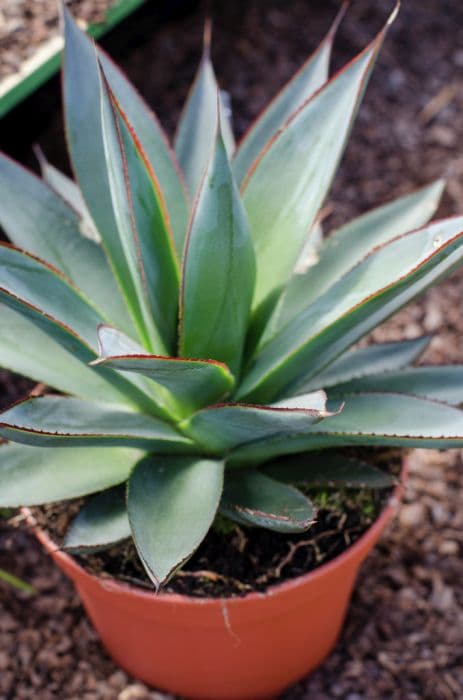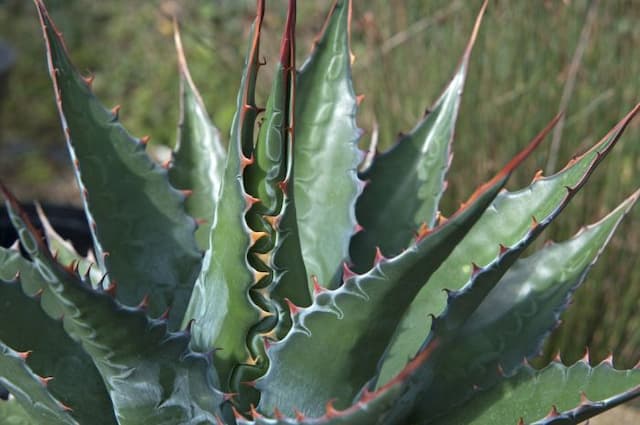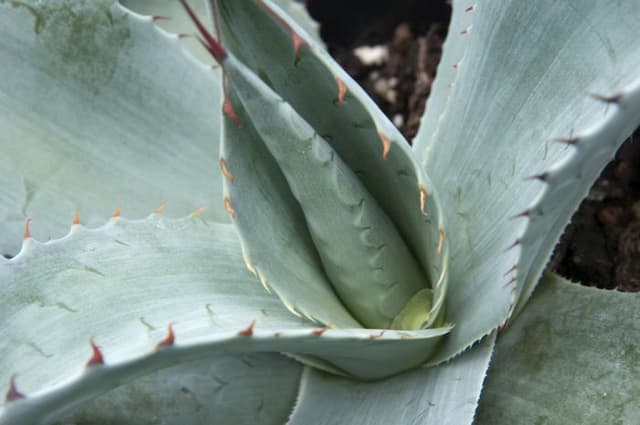Pineapple Lily Eucomis montana

ABOUT
The plant known as the mountain pineapple lily, which carries the name Eucomis montana, presents a unique and charming appearance, reminiscent in some ways to a pineapple, hence its common name. The plant possesses a rosette of long, strappy leaves that are rich green in color. These leaves are broad, and often exhibit wavy edges, undulating gently along their length and creating a lush, full appearance at the base of the plant. In the summer, the mountain pineapple lily produces a striking flower spike, which is the focal point of its charm. The spike is topped with a tuft of green, leaf-like bracts that resemble the crown of a pineapple. Below this tuft, small, star-shaped flowers densely cluster around the robust stem. The flowers are usually cream or light green with possible hints of purple or burgundy, depending on the variety. The texture of the leaves and stem can be described as slightly fleshy or succulent, which gives the plant a robust look. The overall form of the plant is compact and bulbous, contributing to its exotic appeal. Its unique flower spike combined with the striking foliage arrangement makes the mountain pineapple lily a distinctive and attractive plant that is often used in gardens for ornamental purposes.
About this plant
 Names
NamesFamily
Asparagaceae
Synonyms
Mountain Pineapple Lily, Rough-Leaved Pineapple Flower
Common names
Eucomis montana.
 Toxicity
ToxicityTo humans
The plant commonly known as Pineapple Lily (Eucomis montana) is not widely reported as being highly toxic to humans. However, as with many plants, it may cause mild stomach upset if ingested. It is important to note that while many plants can be safely touched, taste or consumption, particularly by children, should be avoided unless the plant is known to be edible. In the case of the Pineapple Lily, ingestion may lead to symptoms such as nausea, vomiting, or diarrhea. If any part of the plant is ingested and symptoms occur, it is advisable to seek medical attention.
To pets
The Pineapple Lily (Eucomis montana) is similarly not well-documented for severe toxicity in pets. However, as a general rule, many ornamental plants can cause gastrointestinal upset in animals if ingested. Symptoms in pets may include vomiting, diarrhea, drooling, or signs of nausea such as lip licking or increased salivation. If you suspect your pet has ingested any part of the Pineapple Lily, it is best to contact your veterinarian immediately to determine the appropriate course of action. Different animals may react differently to plant toxins, so it is essential to monitor for any signs of distress and seek professional advice.
 Characteristics
CharacteristicsLife cycle
Perennials
Foliage type
Deciduous
Color of leaves
Green
Flower color
Varies
Height
2 feet (60 cm)
Spread
1 foot (30 cm)
Plant type
Bulb
Hardiness zones
7
Native area
South Africa
Benefits
 General Benefits
General Benefits- Aesthetic Appeal: Eucomis montana, commonly known as the mountain pineapple lily, produces unique star-shaped flowers with a tuft of leaves that resemble a pineapple, adding visual interest to gardens.
- Attracts Pollinators: The blooms of the mountain pineapple lily attract bees and other pollinators, which are crucial for the pollination of many plants.
- Low Maintenance: Once established, the mountain pineapple lily is drought-tolerant and does not require frequent watering, making it a low-maintenance option for gardeners.
- Long-lasting Flowers: The flowers of the mountain pineapple lily can last for several weeks, providing a long period of visual enjoyment.
- Container Gardening: Due to its moderate size, Eucomis montana is suitable for container gardening, allowing those with limited space to enjoy its beauty.
- Diverse Landscaping: The unique appearance of the mountain pineapple lily adds diversity to landscaping designs, complementing both modern and traditional garden styles.
- Summer Blooming: Flowering in the summer, Eucomis montana provides color and interest during a season when many other plants have finished blooming.
 Medical Properties
Medical PropertiesThis plant is not used for medical purposes.
 Air-purifying Qualities
Air-purifying QualitiesThis plant is not specifically known for air purifying qualities.
 Other Uses
Other Uses- As a decorative feature in rock gardens, Eucomis montana, commonly known as Pineapple Lily, can be planted among rocks and boulders to add a touch of exotic flair due to its unique flower shape that resembles a pineapple.
- In floral arrangements, the cut flowers of Pineapple Lily can be used to create dramatic and long-lasting bouquets, adding height and an unusual texture to the display.
- The plant can be utilized in container gardening, where it adds a striking vertical element to mixed plantings on patios, balconies, or terraces.
- Pineapple Lily serves as an intriguing subject for botanical illustration and photography due to its distinctive flower spikes and rosette of basal leaves.
- In water-wise gardens, this drought-tolerant plant can contribute to an eco-friendly landscape design that requires minimal irrigation.
- As a companion plant, Eucomis montana can be combined with other late-summer bloomers to extend the garden's flowering season and provide continuous visual interest.
- The plant can be a part of a sensory garden, where its unique texture and form can stimulate the sense of touch and sight.
- In a wildlife garden, the flowers of Pineapple Lily can attract pollinators like bees and butterflies, adding to the garden's ecological value.
- Its bulbs can be forced in a greenhouse or indoors during the winter months for a splash of color and to experiment with out-of-season blooming.
- Eucomis montana can act as an educational tool in horticulture and botany programs, demonstrating bulb growth and plant structure to students and enthusiasts.
Interesting Facts
 Feng Shui
Feng ShuiThe Pineapple Lily is not used in Feng Shui practice.
 Zodiac Sign Compitability
Zodiac Sign CompitabilityThe Pineapple Lily is not used in astrology practice.
 Plant Symbolism
Plant Symbolism- Rarity and uniqueness: Eucomis montana, commonly known as Mountain Pineapple Lily, is a relatively rare and unusual plant, symbolizing uniqueness and the value of being different from the common crowd.
- Beauty and attraction: With its striking flower spikes and rosette of leaves, it represents attractiveness and the beauty of the natural world.
- Curiosity and intrigue: Because of its exotic appearance resembling a pineapple, it symbolizes curiosity and the allure of the exotic and unknown.
- Resilience and persistence: As a plant that thrives in mountainous regions, it symbolizes the ability to persist and adapt in challenging conditions.
- Surprise and wonder: The Mountain Pineapple Lily can be a symbol of the unexpected surprises in life, due to its unusual flowers that can seem surprising to those who are unfamiliar with it.
 Water
WaterThe Pineapple Lily, or Eucomis montana, prefers consistent moisture during its growth period. Water the plant deeply to thoroughly soak the soil once a week, using approximately 1 gallon of water each time. In hot, dry periods, increase watering frequency to twice a week. Always check the soil moisture before watering; the top inch should be dry to the touch. Reduce watering in the fall as the plant prepares for dormancy, and over the winter, water sparingly, just enough to prevent the soil from completely drying out.
 Light
LightThe Pineapple Lily thrives in full sun to partial shade. It performs best when it receives at least six hours of sunlight per day. An ideal spot would be in a southern or western exposure, where it receives ample light without being subjected to the harshest midday sun which could potentially scorch the leaves.
 Temperature
TemperatureThe Pineapple Lily prefers warm temperatures and requires a minimum temperature of about 50 degrees Fahrenheit to survive. The ideal growing temperature range for this plant is between 65 and 75 degrees Fahrenheit. Protect the plant from temperatures that drop below 50 degrees by bringing it indoors or providing some form of frost protection.
 Pruning
PruningPruning the Pineapple Lily is primarily about removing spent flower stalks and any yellowing or dead leaves to encourage healthier growth and a tidier appearance. It's best to prune the plant after flowering, typically in late summer or early fall. Remove the flower stalks at their base, and trim away any unnecessary foliage.
 Cleaning
CleaningAs needed
 Soil
SoilPineapple lily prefers well-draining soil with a slight acidic to neutral pH of 6 to 7. A good potting mix would consist of two parts loam, one part peat, and one part sand to ensure proper drainage and aeration.
 Repotting
RepottingPineapple lily should typically be repotted every two to three years to refresh the soil and accommodate root growth.
 Humidity & Misting
Humidity & MistingPineapple lily thrives in average room humidity levels around 40-50%.
 Suitable locations
Suitable locationsIndoor
Place in bright, indirect light and well-draining soil.
Outdoor
Plant in well-drained soil with full sun to partial shade.
Hardiness zone
7-10 USDA
 Life cycle
Life cycleEucomis montana, commonly known as the Mountain Pineapple Lily, begins its life cycle as an underground bulb. In spring, the bulb sends up a rosette of strap-shaped leaves, followed by a tall flower spike resembling a pineapple in summer, adorned with a clump of green bracts at the tip. After pollination, typically by insects attracted to its nectar and scent, the flowers develop into three-chambered capsules containing black, flat seeds. The plant then enters a period of dormancy in the winter, with the bulb surviving underground. Seeds dispersed by wind or wildlife may germinate when conditions are favorable, continuing the species' life cycle. Throughout its life, the Mountain Pineapple Lily requires well-drained soil and moderate moisture to thrive.
 Propogation
PropogationPropogation time
Summer to autumn
Eucomis montana, commonly known as the Mountain Pineapple Lily, is usually propagated through offsets, which are small bulb-like structures that form at the base of the parent plant. The ideal time to propagate this plant is in late summer to early fall, after the foliage has died down. To propagate using offsets, one should carefully dig up the plant and gently separate the offsets from the main bulb, taking care not to damage the roots. Each offset should have some roots attached. These can then be planted directly into the ground or into pots with well-draining soil, placed at a depth where the top of the offset is just below the soil surface. It's important to water them sparingly until signs of growth appear, indicating that they have successfully established.









